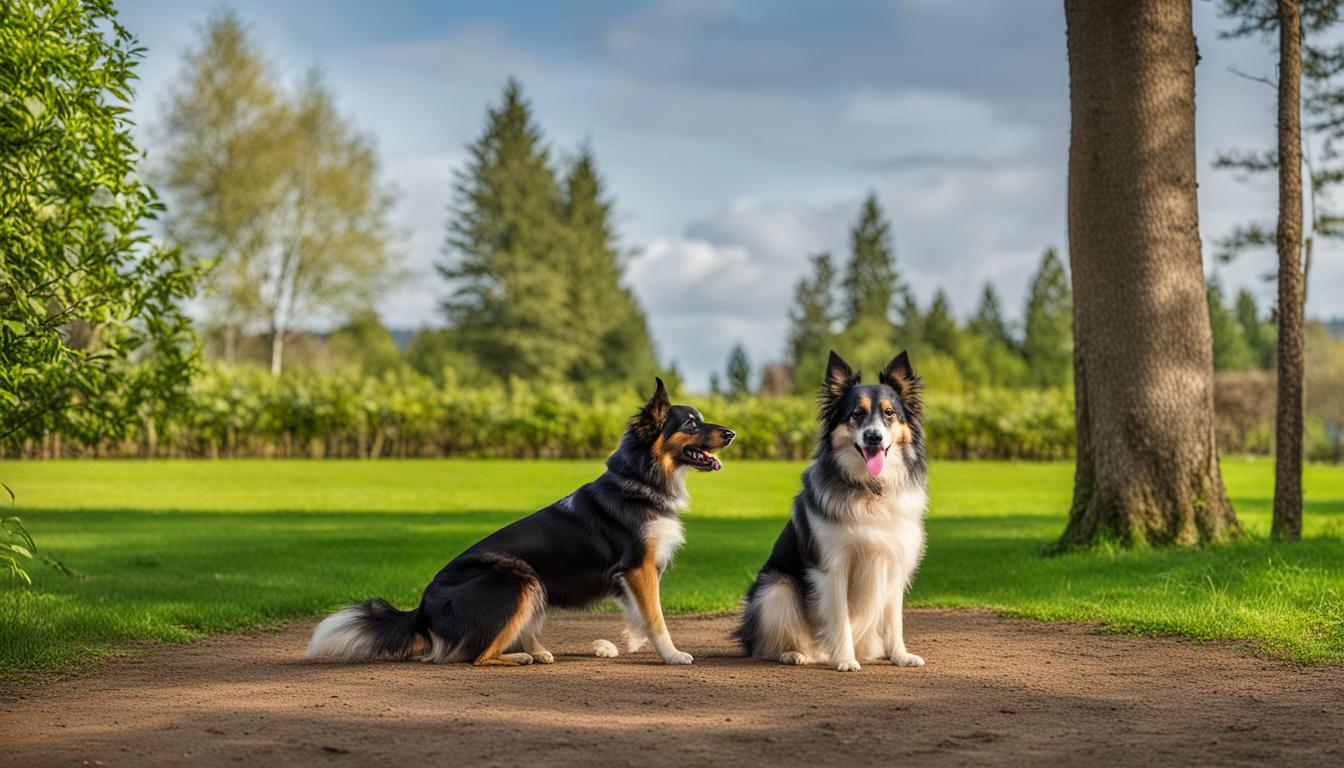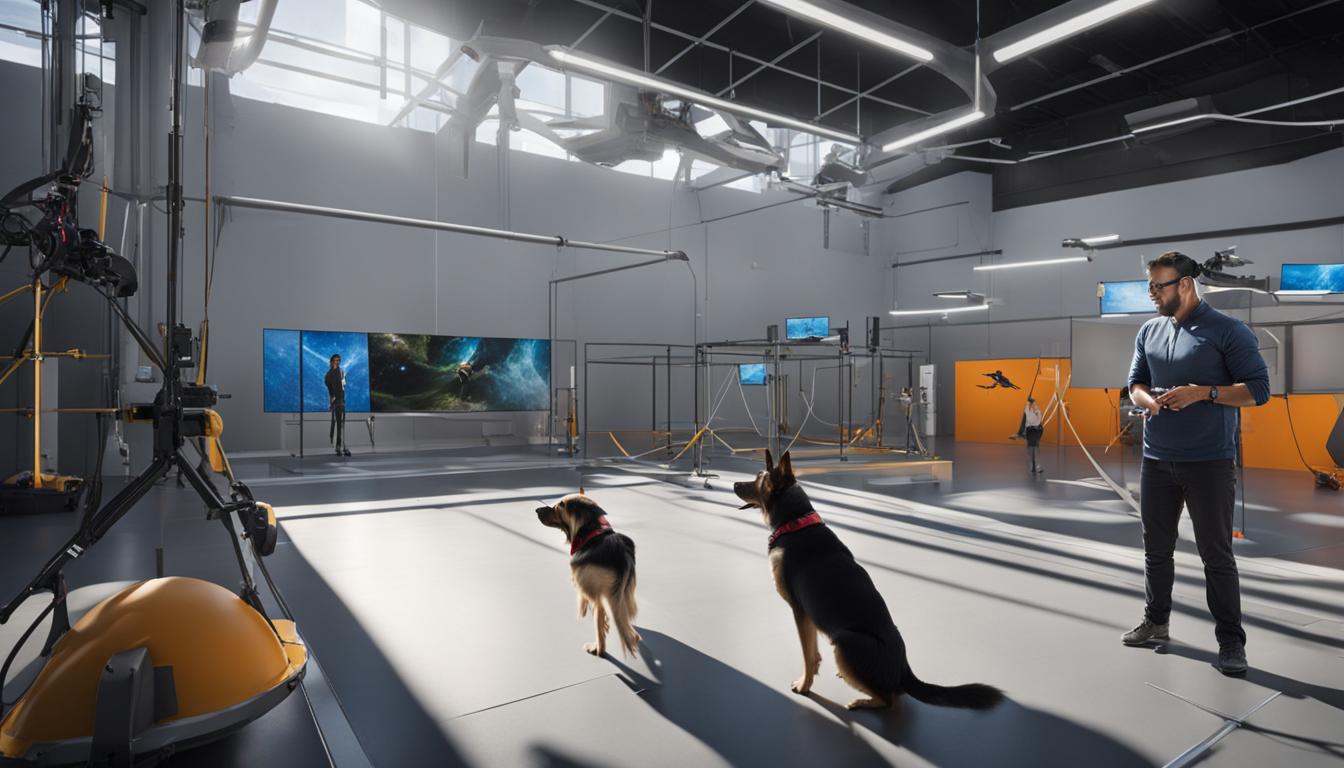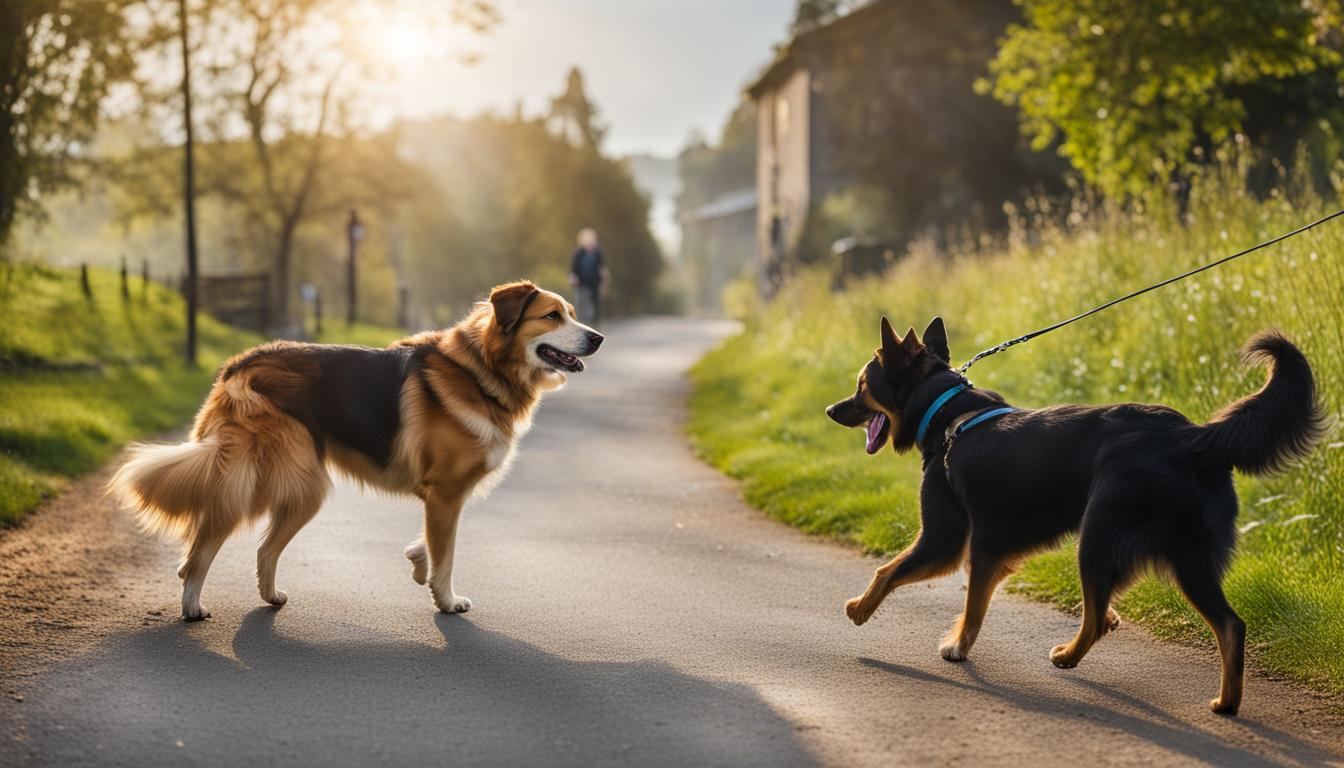Welcome to our article on setting boundaries in dog training. If you want to ensure a well-behaved and happy furry friend, establishing rules and limits is essential. By teaching your dog what is acceptable and what is not, you can prevent behavior problems and strengthen your bond. Let’s explore why setting boundaries is so important in dog training.
Key Takeaways:
- Setting boundaries is crucial for successful dog training.
- Establishing rules and limits helps prevent behavior problems.
- Teaching your dog what they can and cannot do creates a safer environment.
- Consistency in enforcing boundaries is key to training effectiveness.
- Being the pack leader and providing clear communication is essential in setting boundaries.
The Importance of Establishing Boundaries
Dogs thrive when they have clear boundaries. By establishing personal space boundaries, you can teach your dog to respect your personal space and prevent unwanted behaviors. Consistency in setting boundaries is crucial for effective training.
Teaching Dogs Personal Space Boundaries:
- Define specific areas in your home where your dog is allowed and not allowed to go.
- Use physical cues like gates or baby gates to visually block off areas that are off-limits.
- Provide positive reinforcement and rewards when your dog respects the boundaries.
Consistency in Setting Boundaries:
- Set clear and consistent rules from the beginning.
- Ensure that all family members enforce the same boundaries.
- Be consistent in correcting your dog when they cross the boundaries.
Training Dogs to Respect Boundaries:
- Use positive reinforcement to reward your dog for staying within their designated boundaries.
- Consistently reinforce the boundaries by redirecting your dog’s attention to appropriate activities.
- Be patient and consistent in your training efforts, as it may take time for your dog to fully understand and respect the boundaries.
“Teaching a dog personal space boundaries is key to building a strong foundation for training and behavior. Consistency is the key to success in setting boundaries and ensuring your dog understands and respects them.”
The table below provides a summary of the key points to keep in mind when establishing boundaries:
| Key Points |
|---|
| Define specific personal space boundaries |
| Use physical cues to visually block off areas |
| Consistently reinforce the boundaries |
| Reward your dog for respecting the boundaries |
| Be patient and consistent in your training efforts |
Creating Physical Barriers as Visual Cues
When it comes to setting boundaries for your dog, creating physical barriers or visual cues can be an effective training technique. These physical boundaries help reinforce the desired behavior and prevent your dog from crossing into restricted areas. By associating a specific area with a “do not cross” line, you can train your dog to understand where they are allowed to go and where they should not venture.
One simple way to create a physical barrier is by using mini traffic cones or painters tape to mark the boundary line. Place the cones or tape strategically to clearly define the boundary, ensuring that your dog can visually recognize it. This visual cue serves as a constant reminder for your dog to respect the boundaries you’ve established.
“Creating physical barriers gives your dog a clear visual cue of where they are allowed to go, reinforcing the boundaries you’ve set.”
Physical barriers can also be used to redefine specific zones or rooms within your home. By blocking off access to certain areas, such as bedrooms or the kitchen, you can teach your dog to stay within designated areas. This not only helps to maintain cleanliness and organization but also prevents your dog from engaging in unwanted behaviors in restricted spaces.
| Benefits of Creating Physical Barriers | Effective Boundary Training Techniques |
|---|---|
| Prevents dogs from crossing into restricted areas | Use of mini traffic cones or painters tape to mark boundary lines |
| Reinforces desired behavior | Strategic placement of physical barriers |
| Helps define specific zones within the home | Blocks off access to certain areas |
Remember that consistency is key when using physical barriers as visual cues. Reinforce the boundaries consistently by redirecting your dog’s attention to the designated areas and gently guiding them away from restricted spaces. With time and practice, your dog will learn to respect the boundaries and will understand where they are allowed to go.
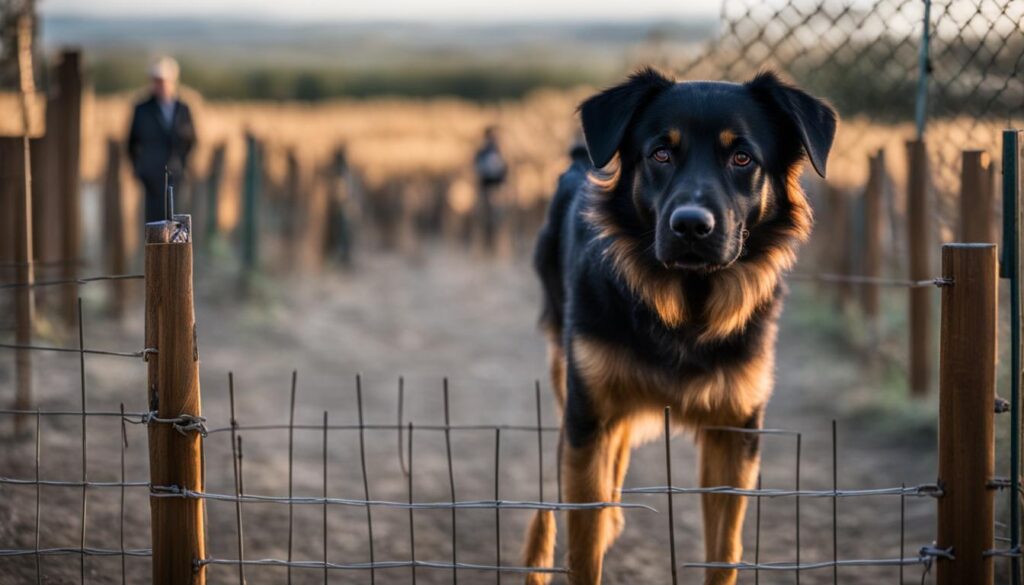
Leadership and Clear Communication
Establishing boundaries requires strong leadership and clear communication from the dog owner. Dogs look to their owners for guidance and direction, so it’s important to set clear expectations and establish yourself as the pack leader. By doing so, you can effectively communicate what is acceptable behavior and reinforce the boundaries.
One way to establish yourself as the pack leader is by always going through doorways first. This act reinforces your position as the leader and helps your dog understand their place in the pack. Additionally, providing consistent exercise and walks can help build a stronger bond between you and your dog, emphasizing your role as the one to look to for guidance.
Teaching your dog to look to you for guidance is essential in maintaining boundaries. When your dog understands that you are the one in charge, they will be more likely to follow the rules and respect the established boundaries. This clear communication helps prevent behavioral issues and strengthens the relationship between you and your dog.
| Benefits of Leadership and Clear Communication |
|---|
| Establishes you as the pack leader |
| Helps your dog understand their place in the pack |
| Prevents behavioral issues |
| Strengthens the relationship between you and your dog |
Correcting Improper Behavior
When it comes to training your dog and establishing boundaries, correcting improper behavior is an essential part of the process. By addressing and redirecting unwanted actions, you can guide your dog towards correct behavior and reinforce the boundaries you have set.
Timing is crucial when correcting your dog’s behavior. It is important to correct them as they are about to cross the boundary, connecting the correction to the action and helping them understand what they are doing wrong. Consistency in using signals, such as a verbal cue or body language, can help reinforce the boundaries and guide your dog towards correct behavior.
One effective way to correct improper behavior is through boundary-based training exercises. These exercises are designed to teach dogs to respect boundaries and understand the consequences of crossing them. For example, you can set up a boundary line and train your dog to stay behind it until given permission to cross. This helps them learn self-control and reinforces the importance of respecting boundaries.
Boundary-Based Training Exercise:
- Set up a boundary line using visual cues such as mini traffic cones or painters tape.
- Show your dog the boundary line and establish that they are not allowed to cross it.
- Guide your dog back whenever they approach or attempt to cross the boundary line.
- Use consistent verbal cues and body language to reinforce the boundaries and correct improper behavior.
- Reward your dog with praise and treats when they respect the boundary and exhibit correct behavior.
| Improper Behavior | Correct Behavior |
|---|---|
| Jumping on furniture | Teaching your dog to stay off furniture and providing them with their own designated resting areas. |
| Begging for food | Teaching your dog to wait patiently and not beg for food during mealtimes. |
| Pulling on the leash | Teaching your dog to walk calmly on a loose leash without pulling. |
By consistently correcting improper behavior and reinforcing boundaries, you can help your dog understand what is expected of them and guide them towards becoming a well-behaved companion.
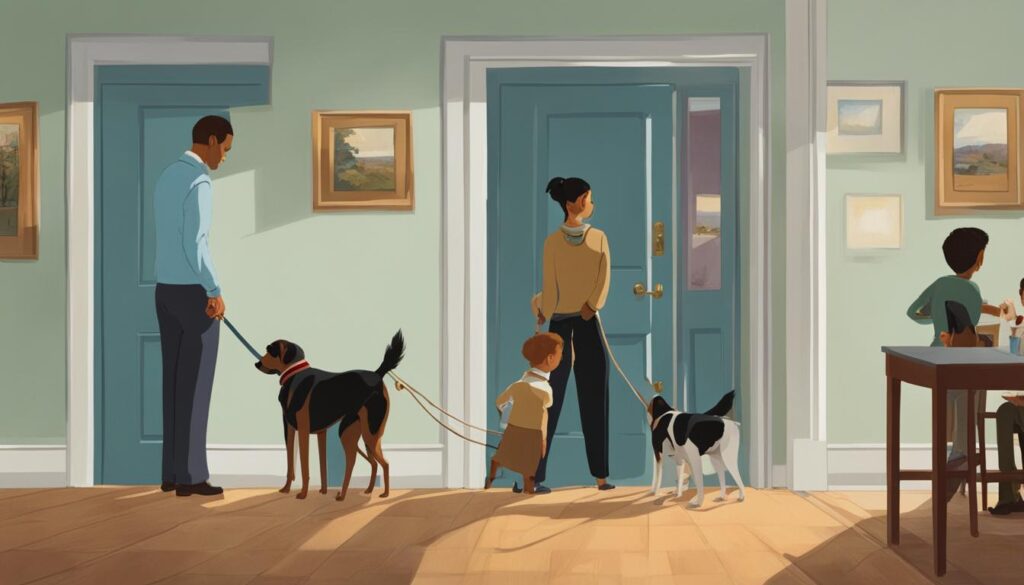
Table: Consistency in Setting Boundaries
| Benefits of Consistency | Tips for Maintaining Consistency |
|---|---|
|
|
The Benefits of Setting Boundaries
Creating a safer environment for dogs and building a better relationship with your furry friend are just a few of the many benefits of setting boundaries in dog training. Boundaries provide dogs with structure and guidance, helping to prevent unwanted behaviors and promote good behavior. By establishing clear rules and limits, you can create a safe and happy space for both you and your dog.
When boundaries are in place, dogs understand what is expected of them, which reduces stress and anxiety. They learn to navigate their environment without causing trouble or getting into dangerous situations. For example, setting boundaries around certain areas of the house, such as the kitchen or bedrooms, can prevent your dog from entering those spaces and potentially causing damage or getting hurt.
Setting boundaries also helps in building a better relationship with your dog. Dogs thrive on consistency and structure, and by providing clear boundaries, you become a reliable and trustworthy leader in their eyes. When dogs understand their limits and what is expected of them, they feel safer and more secure, leading to a stronger bond between you and your furry companion.
Moreover, by setting boundaries, you can reinforce your role as the pack leader. Dogs naturally look to their human owners for guidance, and by establishing clear boundaries, you can effectively communicate your expectations and maintain control over their behavior. This not only helps in day-to-day interactions but also promotes good manners and improves overall obedience.
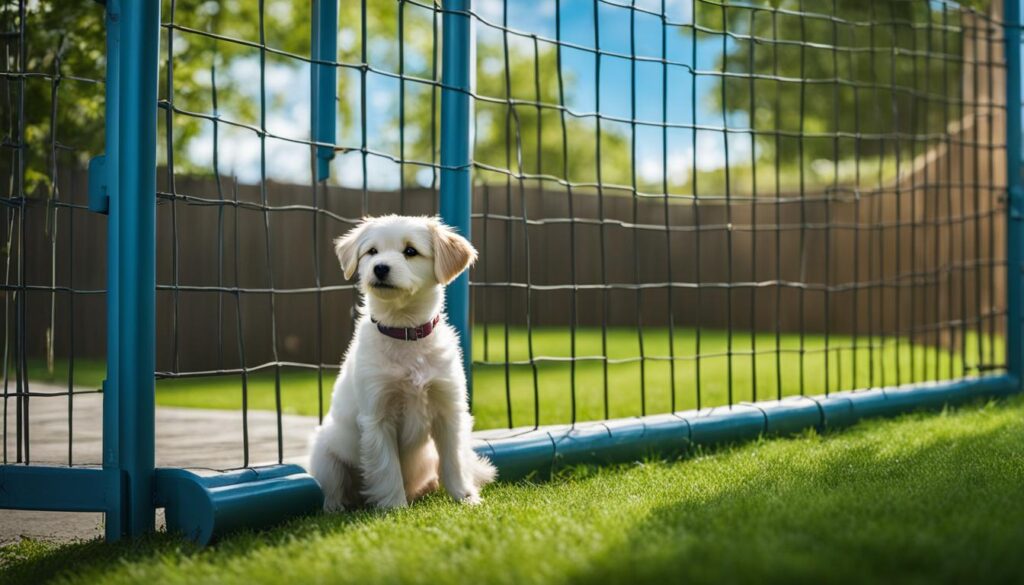
The Importance of Consistency
Consistency is key when it comes to setting boundaries. Dogs thrive on routine, and consistent reinforcement of boundaries helps them understand the rules and expectations. It is important for all family members to be on the same page and enforce the same boundaries, as inconsistency can confuse dogs and undermine the training progress.
| Benefits of Setting Boundaries | Explanation |
|---|---|
| Prevents unwanted behaviors | Setting boundaries helps deter dogs from engaging in behaviors such as jumping, chewing, or excessive barking. |
| Promotes good behavior | Dogs learn what is expected of them and are more likely to exhibit desirable behaviors when clear boundaries are established. |
| Enhances safety | Boundaries create a safe environment by preventing access to hazardous areas or objects that could harm dogs. |
| Strengthens the bond | Clear boundaries help establish trust and confidence between the owner and the dog, leading to a stronger relationship. |
Incorporating Boundaries into Training
To effectively incorporate boundaries into training, use positive reinforcement techniques to reward your dog when they respect the boundaries and exhibit desired behavior. Consistently enforce the boundaries, and gradually increase their freedom as they demonstrate understanding and compliance. With time and patience, your dog will learn to navigate their environment within the established boundaries, creating a harmonious and enjoyable living space for both of you.
Conclusion
Congratulations on completing this guide to setting boundaries in dog training! By establishing clear rules and limits, you are on your way to creating a well-behaved and happy dog. Remember, training dogs to respect boundaries takes time and consistency, but the results are worth it.
By providing your dog with a structured environment, you are helping them feel safe and secure. This promotes good behavior and prevents unwanted actions. It also strengthens the bond between you and your furry friend, as they learn to look to you for guidance and direction.
Always remember to consult a professional, such as a veterinarian or dog trainer, if you need further guidance on setting boundaries and training your dog effectively. They can provide you with tailored advice and support to address any specific challenges you may encounter along the way. Good luck on your dog training journey!
FAQ
Why is setting boundaries important in dog training?
Setting boundaries helps prevent behavior problems and strengthens the bond between you and your dog.
How can I establish boundaries for my dog?
You can establish boundaries by claiming your space, taking the lead as the pack leader, teaching your dog to wait, correcting at the right time, and being consistent.
How can I train my dog to respect personal space boundaries?
One effective way is by creating physical barriers or visual cues using mini traffic cones or painters tape to mark the boundary line.
How can I establish myself as the pack leader?
You can establish yourself as the pack leader by always going through doorways first and providing consistent exercise and walks.
When should I correct my dog’s behavior?
Correcting them as they are about to cross the boundary connects the correction to the action and helps them understand what they are doing wrong.
How important is consistency in setting boundaries?
Consistency is key. All family members should be on board and enforce the same boundaries to avoid confusion.
What are the benefits of setting boundaries for my dog?
Setting boundaries creates a safer environment, prevents unwanted behaviors, and strengthens the relationship between you and your dog.
Can you provide further guidance on setting boundaries and training my dog?
It is recommended to consult a professional, such as a veterinarian or dog trainer, for personalized guidance in setting boundaries and training your dog effectively.

